Planting Position
For most fruits choose a warm sheltered position avoiding wet or shaded spots, although soft fruit will tolerate some shade. Avoid north walls except when planting blackberries which will crop successfully, albeit, a little later in the season. Crops are likely to be sparse in frosty situations. If birds are troublesome a fruit cage can be erected.
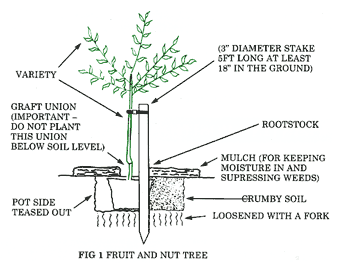
Soil Preparation
Prior to planting eliminate all perennial weeds. If the soil is acid mix in lime, add organic matter such as compost or manure to light sandy soils. On heavier soils, which are poorly drained, planting on raised beds is beneficial. The incorporation of sand is also helpful. Before planting dig in a handful of fertiliser such as ‘Growmore’ also a light sprinkling of Magnesium Sulphate (Epsom Salts) to each planting position.
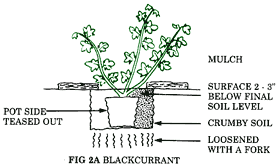
Staking and Planting Fruit
Select a fine day for planting when the soil is not sticky. When planting a tree it is necessary to drive a 2-3 inch diameter stake 18-24 inches into the soil. The length above the soil should leave the top 3 inches clear of the tree head. Upright “Minarettes” also require an individual stake but this needs to be 6 feet above the soil level.
Espalier or fan-trained trees are planted against a wall or free standing fence for training as illustrated (Figs 5 & 6), individual stakes are not required.
Blackberries, loganberries, tayberries and raspberries, collectively known as cane-fruit, require the support of wire work. It is desirable to erect this before planning. Sometimes existing fences and walls can be utilised by attaching parallel wires with “Vine eyes” or equivalent. Fencing details are shown under “Soft Fruit Culture”.
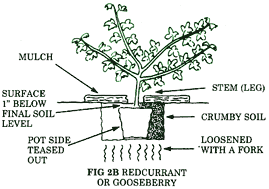
Having inserted the stake or erected the fence-work dig a hole around the stake or selected position at the base of the fence. For trees the hole needs to be one foot deep and two feet across, (see Fig 1) but in the case of soft fruit it can be smaller (see Fig 2). Loosen the soil at the bottom of the hole with a fork. Before removing the plant from its container ensure that the compost is thoroughly moist by soaking the pot in a bucket of water. Now the plant can be removed. Note: In the case of raspberries there can be 10 canes in the pot. If so, carefully separate them and plant individually. Having removed the plant, tease out the outer root region which has been restrained by the pot. When planting trees, position these in the hole so that the trunk (stem) is three inches from the stake, or in the case of trained trees, position in the desired spot below the fence or against the wall. Keep the stem three inches from the wall. The union must be at least four inches above the surrounding soil level and the eventual height of the union can easily be adjusted by adding sufficient soil to the bottom of the hole. When you are satisfied the tree is in position, start returning the broken up soil to the hole
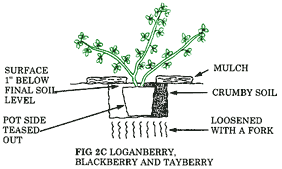
Soft- fruit plants are planted in the same manner as trees with very slight modification and of course, there is no ‘ budding’ union or stake to consider )see Figs 2a, 2b, 2c & 2d). The important variations are that blackcurrants require planting rather deeper so the plant crown is three inches below the surface, whereas raspberry canes require shallow planting, with the original level only one inch below the surface. Plants may or may not have leaf according with the time of year when planted.
Tying Fruit Trees and Soft Fruit Plants
Secure the tree to the stake with a figure eight to chainlock strapping or other suitable purpose made tie, or in the case of trained trees tie in the branches to the supports with soft tying material. Wire-netting or plastic spiral guards should also be applied if pests are a problem and damage to the stem is anticipated. Soft fruit bushes generally do not need tying at planting although some cane fruit may do.
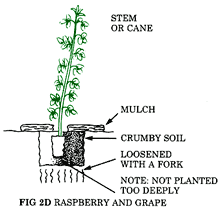
Mulching
This helps to retain moisture in the soil and also suppresses weeds. Mulch 18 inches around the plant base with a 2 inch layer of peat, well rotted manure, compost, forest bark or suitable equivalent. Whatever is used keep the mulch clear of the plant stem, otherwise mice will sit there and chew the bark. If the plants are in rows the mulch can be continuous allowing 12-18 inches on each side.
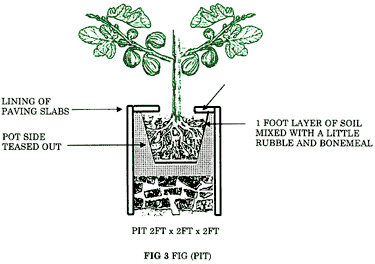
Fruit Trees are Composed of Two Parts
a) The Rootstock – Governs the vigour and tree size.
b) The Variety – The fruit bearing section
We have selected the rootstocks for you, namely M9, M27, M26 and MM106 for the apples, and Quince ‘A’ for the pears. These rootstocks produce compact bush trees ideal for garden use. They can be planted 8-10 feet apart. Staking is advisable.
Note – our bush apple trees available on M27 rootstock produce very small trees and we highly recommend them for growing in pots on patios or 6 feet apart in very small gardens.
For the dwarf plums PIXY is our choice, plant 8-10 feet apart. For the cherries we use COLT, a dwarf stock, but it does require 15-18 feet spacing.
Fan and Espalier apples require a fairly strong stock and we favour MM.106, similarly the pears are often Quince ‘A’, all need planting 15 feet apart. Plum and peach fans may be on either St. Julian ‘A’ or Pixy, if on St. Julian ‘A’ plant 15 feet apart, but only 12 feet if on Pixy;
Figs are grown on their own roots and when planting, the rooting area must be restricted to prevent the tree from becoming vigorous, large and unfruitful. See FIG PIT (Fig 3E) or by planting in a large tub or pot.
Figs and Cobnuts/Filberts are grown on their own roots. Grapes may be grafted onto a rootstock or grown on their own roots.
You may not have come across ‘Minarettes’ before, by this method of training a number of apple varieties may be grown closely together. In fact, if you have decided to plant these they are normally on M.26 and can be planted 2 ½ – 3 feet apart. To get the best from this type of tree our pruning instructions must be carefully followed. (see page 11).
Choice of Variety
Having chosen your variety it is usually essential to select a second variety since cross pollination is necessary for successful cropping. Refer to the pollination table on the back cover.
Note – Apples and pears do not cross pollinate each other.
The cherry varieties Morello and Stella are self-fertile and can therefore be planted singly. Some of our plums and pears are also self-fertile but cross pollination is beneficial. Peaches are also self-fertile but pollination can be improved by picking off a few well opened flowers are carefully brushing these across the other opened flowers.
Figs, Cobnuts/Filberts and Grapes are self-fertile.
Considerations For Container Grown Fruit Trees
When growing fruit trees in containers, there is generally more care required than for the fruit trees that are planted in the ground. Generally, fertilizing should be done more often. We recommend using Growmore (7-7-7) once every 4 to 6 weeks during the growing season. Also, watering must be done more frequently. Generally, watering will need to be done 2 to 3 times a week during early to mid Spring, while almost daily watering may be required during the hot summer months. Some factors to consider for the frequency of watering are the container size, the exposure to wind and sun, the type of soil you use, and the outside temperature. Generally, the larger the container, the less frequent you will have to water. Smaller containers generally dry out faster than larger containers. The more wind your plants are exposed to, the more water they will need. Wind can dry your containers out quickly, even if it isn’t a particularly warm day. Also, depending on your soil mix you may need to adjust your watering. Soils that drain very quickly will need to be watered more often than soils that are heavy and retain water. In the end, you will have to be the judge of when and how much to water. For those who are new to container gardening, be observant and check your plants at least a couple of times a week. For those who want to container garden, but aren’t sure they will remember to water, set up a drip irrigation system for your container plants and use a timer. That will alleviate some of the worries.
Fruit Trees That Grow Well in Containers
Not all fruit trees will grow well in containers for long periods of time. If you want to grow a fruit tree in a container for just a couple of years, then you can grow just about any fruit tree. However, if you want to grow a fruit tree in a container for its entire life, then you may want to try some of the fruit trees listed below. The size of container plays a factor in what you can or can’t grow. Generally, you will want to use a container that measures 18 – 24 inches wide and about the same depth. Larger containers can be used as well. Wine barrels cut in half are often used. It really doesn’t matter the material of the container as long as there is adequate drainage. Some of the fruit trees that can be grown well in containers are dwarf (M27) Apples , dwarf (Pixy) Plums, dwarf (Giesla 5)Cherries, genetic dwarf nectarines, genetic dwarf peaches.
Containers
Terracotta pots provide weight for stability but should be frost resistant. Lighter plastic pots are better if plants require moving around. Pot plants up in stages, aiming for minimum final pot size of 45cm (18in) if the plant is to be moved around. Larger pots can be used where trees are to remain in situ all year round.Compost
A loam-based compost such as John Innes No 3 is best in most cases and provides weight for better stability. For plants requiring ericaceous soils use ericaceous John Innes composts or an ericaceous multi-purpose compost. Place 5cm (2in) of crocks or gravel over drainage holes and raise pots on feet in winter to avoid waterlogging.
Care
Container-grown trees are more prone to drying out and need regular and thorough watering. Several waterings may be needed to wet the full depth of compost. Use rainwater for ericaceous plants, although tap water is better than none if you run out.
Apply a controlled-release fertiliser at the start of the growing season or use a liquid feed at regular intervals.
Refresh the compost in spring by removing 5cm (2in) of dry, loose compost near the surface and replacing it with some fresh compost mixed with some controlled-release fertiliser. If trees are tolerant of root disturbance, every three to five years remove the tree from its pot and tease out the roots loosening the old compost. After trimming the larger roots, repot in fresh compost.
Copyright © 1999-2010 Blackmoor Estate Ltd